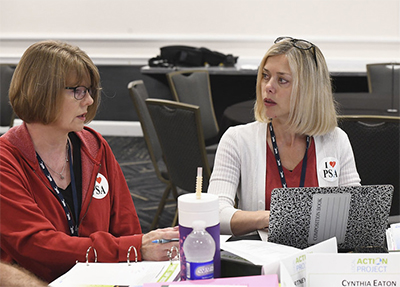Cynthia Eaton
If there’s one point that was driven home this summer when working as a Brightspace Faculty Fellow (BFF) with colleagues from across the college, it is this:
The point is obvious, I know, given that we work at a community college with courses ranging from chemistry to culinary, engineering to English, astronomy to art, physics to phys ed. But between chairing the DEC subcommittee on course proposals and reviewing 131 proposals last spring and doing BFF mentoring this summer, it was actually pretty amazing to see the range of approaches in faculty’s course design and pedagogical approaches. We will work hard to ensure that everyone at the college understands the various pedagogical and technological approaches appropriate to each discipline and to avoid anything like a one-size-fits-all approach to developing, teaching and evaluating DE courses. What I learned this summer And for someone who’s been teaching DE courses for a quarter century? Wow, this summer was humbling! Just when I thought I might know a thing or two. Case in point: Jim Swike, adjunct instructor of history, asked me about setting up groups. “No problem,” I confidently responded, “I set up groups in my summer Brightspace class.” Thing is, Jim has his students self-enroll into groups. I had never done this. Jim and I worked on it via some Zoom sessions, and we finally figured it out together! In mid-July, working with Fifi Anastasiadis, adjunct assistant professor of business, I kept indicating that her institutional home page should look a certain way. Fifi said, “That’s not what I’m seeing,” and when she shared her screen I realized that faculty teaching at multiple SUNY institutions see all of their Brightspace courses listed there. I learned from Lyle Wind, adjunct instructor of political science, the importance of clarity in describing discussion forums vs. topics in Brightspace because the Blackboard terms were different and that can throw people off. Adjunct assistant professor of English Richard Posner and I worked through several ideas regarding email in Brightspace, taking attendance in the LMS and exploring various widgets and what they do and don’t do. Bonnie Bambara, adjunct instructor of reading, brought forth several conversations about how developmental courses need a special pedagogical approach, more scaffolding and more instructional how-to pages. Debbie Keith-Serafy, adjunct associate professor of biology, has devoted untold hours to carefully narrating PowerPoint slides, exporting them as .mov files, uploading them to her private YouTube channel and linking them in her Brightspace page. Mary Farina, adjunct assistant professor of interior design, showed me the ways she was using Brightspace to better ensure alignment of her INT101 on-campus class with others taking INT101 online because next spring they will all be in the same section of INT102. All of the adjunct faculty I worked with this summer showed incredible commitment to being as ready as possible to help our students. I am impressed with their above-and-beyond work and thankful to have learned with and from each of them. Still building Brightspace Basics Another adjunct who has helped me is Shelly Shumway, adjunct assistant professor of physics and one of our EC reps. Shelly reached out to advocate for clearer support for faculty. We talked about how no matter the discipline, all courses involve three core elements: we all 1) disseminate information and materials to students, 2) receive work from students and 3) communicate with students. Thus, we revised the Brightspace Basics page on the FA website into columns in those three categories. This way, as Shelly noted, things feel less overwhelming. If an adjunct is teaching on campus, they might only use Brightspace to distribute course materials and can focus on materials in that left column. When they’re ready, they can start incorporating student work into their class website using Assignments, Discussions or Quizzes and focus on the materials in the middle and right columns. I appreciate the feedback and will continue to add files to that page as often as I can. I am grateful to all of the FA members from whom I learned so much this summer, given their smart questions about and ideas on their wide range of approaches in course design and pedagogical strategies. |
